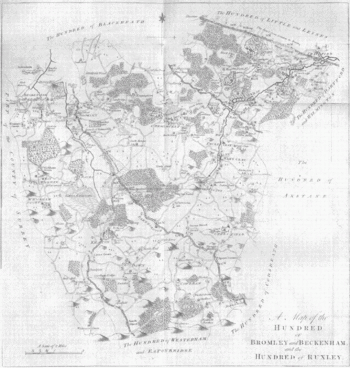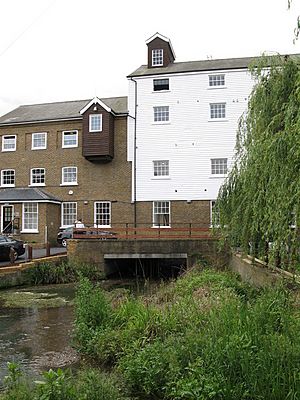Hundred of Ruxley facts for kids
| Ruxley | |

Map published in 1797 showing the hundred of Ruxley |
|
| Geography | |
| Status | obsolete |
| 1831 area | 36,320 acres (147 km2) |
| 1851 area | 36,431 acres (147 km2) |
| HQ | Ruxley |
| History | |
| Created | in antiquity |
| Abolished | 1884 - 1965, see chart |
| Succeeded by | Bromley Rural District, and Bexley Urban District, see chart |
Quick facts for kids Demography |
|
|---|---|
| 1831 population | 12,329 |
| 1851 population | 16,312 (in 3026 houses) |
| Politics | |
| Governance | hundred |
| Subdivisions | |
| Type | Parishes |
| Units | Chelsfield, Cudham, Downe, Farnborough, Foots Cray, Hayes, Keston, Knockholt, North Cray, Orpington, St Mary Cray, St Paul's Cray, and West Wickham, (plus Ruxley before 1557) and parts of Bexley, Chislehurst, Chiddingstone, and Hever . |
Ruxley was an ancient land division, or "hundred," located in the northwest part of Kent, England. It was also known as Rokesley and Helmestrei in older records. Today, most of the area that was once Ruxley has become part of London. Its name now refers to a specific district.
The former area of Ruxley covers a large part of the London Borough of Bromley and the London Borough of Bexley. A small piece is also in the District of Sevenoaks in Kent. Ruxley was part of a larger region called the Lathe of Sutton-at-Hone.
This old hundred stretched about 14 miles (22.5 km) from north to south and 8 miles (13 km) from east to west. The River Cray was the most important river in Ruxley. It flowed north through many of its parishes, with four of them even named after the river! The River Cray starts in Orpington and flows through places like St Mary Cray and Foots Cray before leaving the Ruxley area. In 1797, Ruxley was split into two "half hundreds" called Upper Ruxley and Lower Ruxley, each with its own local officer called a constable.
Today, almost all of the Ruxley area is part of London. Because of this, most of the old local divisions (civil parishes) were removed. Only Knockholt, in the south, remains a civil parish today. It is also the only part of the original Ruxley hundred that is still in Kent.
Contents
Parishes of Ruxley
A "parish" was a small local area, often centered around a church. Many parishes were completely within the Ruxley hundred. These included Chelsfield, Cudham, Downe, Farnborough, Foots Cray, Hayes, Keston, Knockholt, North Cray, Orpington, St Mary Cray, St Paul's Cray, and West Wickham.
Some other parishes were only partly in Ruxley or moved in and out over time. These were Bexley, Chislehurst, Chiddingstone, Hever, and Ruxley itself. The original settlement of Ruxley even had its own parish until 1557, when it became part of the North Cray parish.
Ruxley's Borders and Neighbours
Ruxley was located in a central spot within the Sutton-at-Hone lathe. It shared borders with almost all the other hundreds in that lathe. To the north, it bordered Little and Lesnes. To the east and northeast were Dartford and Wilmington, and Axstane. To the southeast was Codsheath, and to the south, Westerham and Edenbridge.
Ruxley's southwestern border was also part of the county line between Kent and Surrey. To the west, it bordered Bromley and Beckenham, and to the northwest, Blackheath. The only hundred in the Sutton-at-Hone lathe that didn't directly border Ruxley was Hundred of Somerden. However, Ruxley had a small separate piece of land (called an "exclave") several miles south in the Somerden area. This exclave included parts of the Hever and Chiddingstone parishes. If this exclave is counted, then Ruxley would have bordered every other hundred in the Sutton-at-Hone lathe!
When Greater London was created in 1965, Ruxley's old eastern and southern borders became part of the new borders between the London Boroughs of Bromley and Bexley and the Kent districts of Sevenoaks and Dartford.
Watermills of Ruxley
The Ruxley hundred was home to eight watermills along the River Cray. These mills used the power of the river to do work, like grinding grain or making paper. Let's explore them from the river's start to its end:
Orpington Mill
TQ 467 669 This mill was mentioned in the Domesday Book, a very old survey from 1086. It stood near where the River Cray begins. The mill building was from the 1700s and had a large waterwheel. Later, a steam engine was added, and its tall chimney was even nicknamed "Colgate's Folly" because it didn't work very well! The mill was used to grind grain and was taken down in the mid-1930s.
Snelling's Mill, St Mary Cray
TQ 472 677 This was another mill mentioned in the Domesday Book. It was taken down in 1872 to make way for a public park. The mill's large cast iron waterwheel was saved and used to pump water for fountains in a nearby estate. Sadly, the wheel was damaged by vandals and removed by 1964.
Upper Paper Mill, St Mary Cray
TQ 472 682 This mill used an "undershot" waterwheel, meaning the water flowed under it to make it turn. It was a paper mill from at least 1757. Paper from this mill sometimes had a special design (a "watermark") that said Martha Lay 1804, after one of the mill owners. The mill stopped working in 1834.
Joynson's Mill, St Mary Cray
TQ 471 684 This started as a corn mill (for grinding grain) but later became a very important paper mill. William Joynson took over in 1834 and made high-quality writing papers. He even got a patent for a way to add watermarks to machine-made paper. By 1881, about 700 people worked here!
In 1914, paper from Joynson's mill was used to make the first £1 and 10/- banknotes! The mill was later bought by another company, Wiggins Teape, and rebuilt to make greaseproof paper. From 1963, it was even home to the National Paper Museum, which later moved to Manchester. The mill closed in 1967.
St Paul's Cray Mill
TQ 474 694 In 1718, this mill had three waterwheels! Two were for preparing leather with oil, and one was for grinding corn. Later, it was replaced by a paper mill that used a modern turbine for power.
Foots Cray (Nash's) Paper Mill
TQ 474 694 This paper mill replaced an older corn mill. Papermaking started here by 1742, and a steam engine was added around 1820. The Nash family owned it for many years, expanding it in 1853. By 1954, it was a large factory complex, but it was taken down by 1986.
Foot's Cray Mill
This was another paper mill. By the 1870s, it was used for printing fabrics. In 1900, it became a factory making photographic film! Its last job was processing silk. The mill had two large cast iron waterwheels. It was taken down in 1929.
Old Mill, Bexley
TQ 496 735 This was one of three mills in Bexley mentioned in the Domesday Book. It was a corn mill. The last building on the site was from 1779. The Cannon family owned it for many years, from 1839 to 1907. A steam engine was added in 1884, and the tall chimney was built by a Mr. Hart, who famously fell from the top but survived! The mill was later used for making sacks. Sadly, it burned down in 1966 and was replaced by a pub called "The Old Mill PH," which has a mill theme.
Changes in Local Districts
Over time, the way the Ruxley area was governed changed a lot, especially as London grew. Before 1934, many parishes like Knockholt, Cudham, and Orpington were part of the Bromley Rural District. Other parishes like North Cray and Foots Cray were also in the Bromley Rural District but later joined the Chislehurst and Sidcup Urban District.
Between 1934 and 1965, many parishes in the Ruxley area became part of the Orpington Urban District or the Municipal Borough of Bromley. Others, like North Cray and Foots Cray, were in the Chislehurst and Sidcup Urban District.
When Greater London was created in 1965, most of the Ruxley area became part of the new London Borough of Bromley or the London Borough of Bexley. However, Knockholt was part of the London Borough of Bromley for a few years (1965-1969) before moving back into Kent, becoming part of the Kent District of Sevenoaks. Some parishes, like Chiddingstone and Hever, which were in a separate part of Ruxley, remained in Kent and are now part of the Kent District of Sevenoaks.


